|
A performance that defies the usual categories is an event in itself. How inspiring to puzzle over what to call this new creation by prolific South African artist William Kentridge: A chamber opera, musical, oratorio, dance theater, multimedia show, surrealist dream? It's all of the above, an audiovisual voyage on an ocean steamer in the year 1941, leaving the port of Marseille to sail to the Caribbean island Martinique in order to escape Nazi persecution.
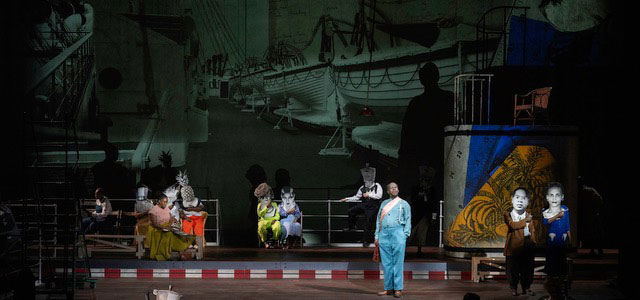
On board, among the refugees are writers, artists, politicians,
thinkers, part of them natives of Martinique. They are fleeing a
Europe that is dominated by colonialism and tyranny. The
allusions to today's political landscapes are obvious.
The mournful African music played by a four-person chamber
orchestra and the ensemble pieces (composed by Nhlanhla
Mahlangu), sung by a chorus and the whole cast, set a course of
mourning and nostalgia not unlike Fellini's E la nave va (And the
Ship Sails On), another sea voyage marking the operatic end of a
world.
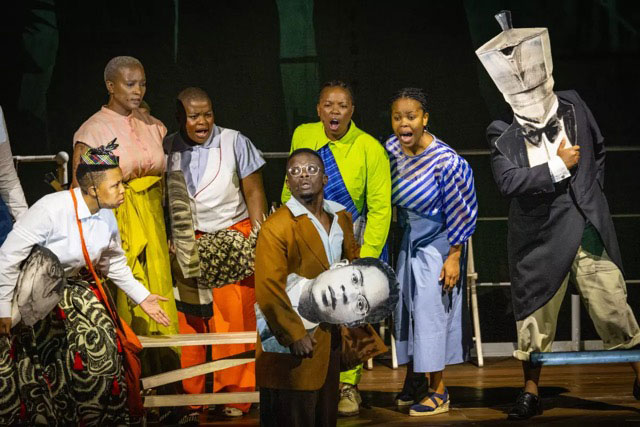
The passengers are a motley crew, mainly from the movements of
Dada and Surrealism. One sports the head of a fish as if sprung
from the palette of Magritte; another is a walking French-Italian
espresso pot – a surreal image Kentridge loves to use in his
artwork. He sometimes names it "the bourgeoisie." There are the
creative minds of the era: Surrealist André Breton, political
philosopher Frantz Fanon, dancer and spy Josephine Baker,
German-Jewish author Anna Seghers (Transit), anthropologist
Lévy-Strauss. The captain (played by Hamilton Dhlamini) with
his bullhorn is Charon, the mythical ferryman of the dead.
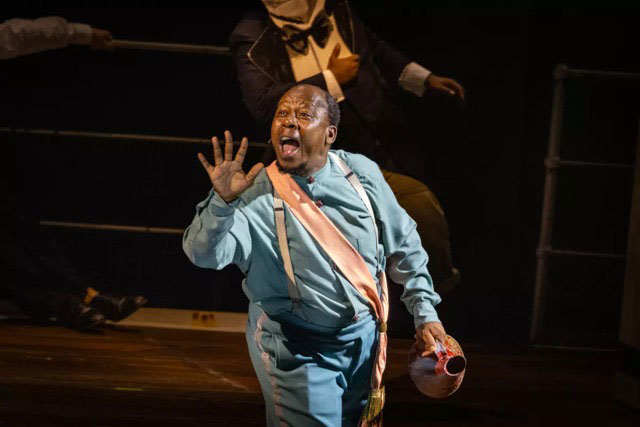
He conjures additional passengers from a revolutionary past on
board. We spot Trotsky in a bathrobe lying in a deck chair while
Stalin does comically threatening crouches nearby. Frida Kahlo
appears wielding a sledge hammer as if to destroy all bourgeois
conventions while Diego Rivera twirls a lasso like a pioneer of a
brave new world. Breton dances a gig with Fanon before splitting
himself to engage with his double – a surrealist mirror act,
perhaps, to catch the unconscious. The costumes (by Greta Goiris)
are exquisite; in the dance movements they turn sculptural. Two
magical dance numbers feature geometrical figures that refer
back to the German Bauhaus, bringing us a vision of Oscar
Schlemmer's influential Triadic Ballet.
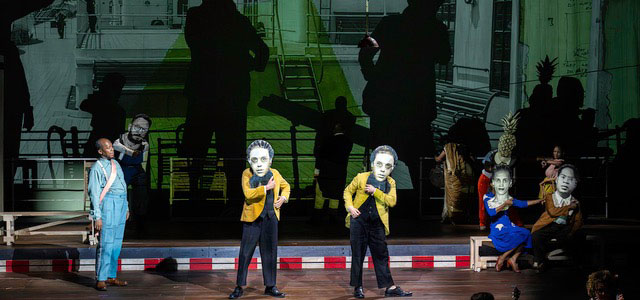
In brief vignettes, the passengers present themselves as live
puppets: the actors/singers hold over-sized cardboard heads like
masks in one hand. The famous faces stare out with over-sized
intensity at the audience while their bodies dance, twitch and
twist to great theatrical and comical effect. The dancers, a man
and a woman(Teresa Phuti Mojela and Thulsni Chauke) , switch
gender unnoticeably behind their masks. Sometimes they also
switch heads: Josephine Baker does a spastic Charleston with
another Josephine of history--Napoleon's first wife who was
raised on Martinique and met the Emperor after a slave revolt
forced her from the island. What do these two
women, one black and one white, have in common that allows
them to switch heads in their dance? This kind of puzzle pervades
the mini scenes and gives them the charming mystery of the
surreal.
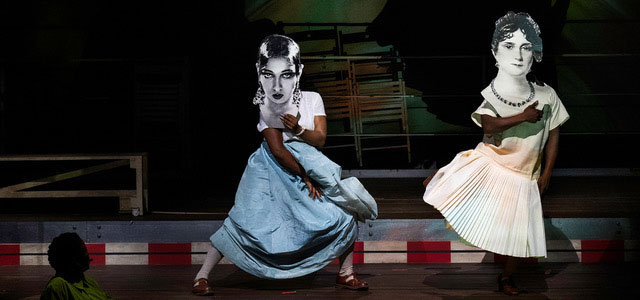
Many vignettes and texts reflect the artistic connections between a
European world, Paris-Marseille, and an African world,
Martinique-South Africa. Several refugees are connected to the
movement of Négritude (Blackness): there are the Nardal sisters,
Paulette and Jeanne, whose salon outside Paris was the hub of
anti-colonial and anti-racist ideas. They are joined by their
prominent compatriot writers Aimé Césaire and his wife Suzanne.
Their writings (Césaire's memoir Notebook of a Return to My
Country) are a major source for the libretto. Suzanne Césaire
(Nancy Nkusi) is repeatedly shown writing, reciting and dreaming
in her cabin – a small space filled with the tropical glow and
poetry of her homeland.
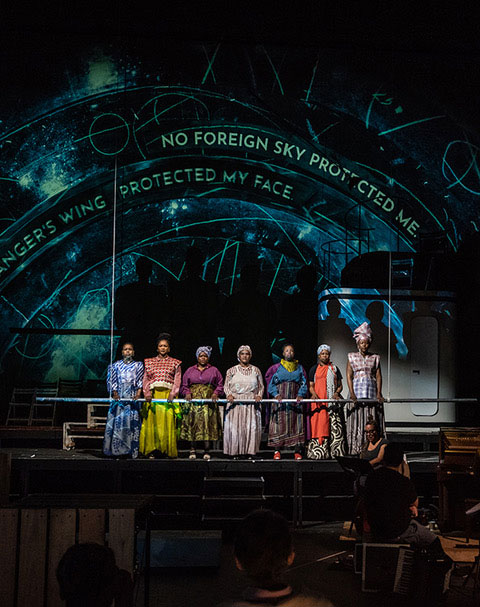
The language is French and English whereas the songs are sung in
the diverse African languages of the chorus members. Snippets of
text appear projected on the background that is a constantly
changing set of giant turning hemispheres – radar screens,
nautical charts, continental maps, night skies, clouds and ocean
waters, turning and melting into Kentridge's abstract art patterns.
The visual impact of the background, all in blueish tones and
greys, and the marvelous set (Sabine Theunissen) is stunning with
its artistic unity of style. Subtitles follow the French spoken
onstage, but are often hard to read in their discrete grey-tones.
One catches snippets like, "I am a witness, a survivor of that time,
that place," "Now the house of justice has collapsed," or, "It was
always too late to save you." A lot of the poetry quoted in French
gets lost in this way, but one gets the message through the
musicality, and Charon, the captain, helps guide the voyage in
English, a powerful emcee who can sing in falsetto and bellow
with the voice of a carnival barker.
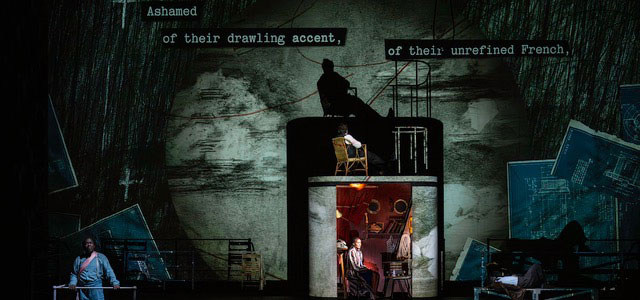
In an African version of a Greek chorus, the village women with
their exquisite singing voices, click sounds and chatter comment
on the different storylines. Animé film projections add humorous
scenes drawn by Kentridge. In one of them, coffee pots, cups and
slices of tarts slide back and forth in the rhythm of waves before
slipping off the table altogether, dragging a black typewriter with
then. In a nod to surrealist films by Luis Bunuel, a white diner's
hands hover over a plate and, wielding knife and fork with gusto,
attack his meal -- a black woman's hand that frantically wiggles
and twists to keep out of reach.
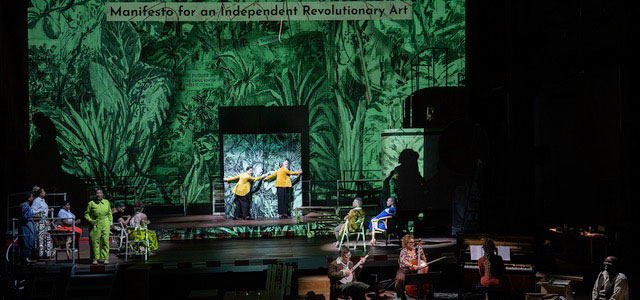
When the island of Martinique comes close, tropical plants and
patterns frame an exquisite film of a black dancer in a skirt of
leaves dancing with himself. In a dreamlike sequence he is
shadow-boxing and simultaneously melting into his own double.
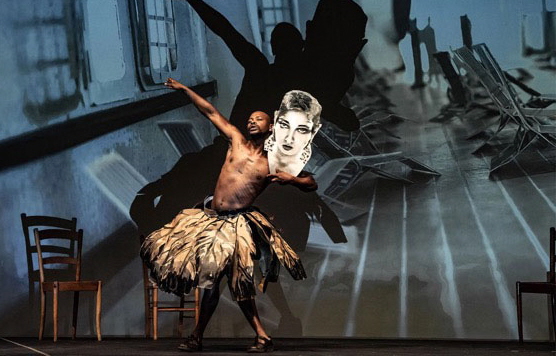
I wished Kentridge had introduced more of such magical,
emotionally stirring scenes. While every element in itself was
perfect: the set, the sculptural costumes (Greta Goiris), the dancer
-puppets, the voices and the musical composition, the sum of it all
seemed to be missing something. The overall impression was
intellectual, even a bit didactic like a lesson in history, a grand
audiovisual lecture on a lost culture before Hitler's destruction of
Europe. An emotional center or personalized operatic drama was
missing for me.
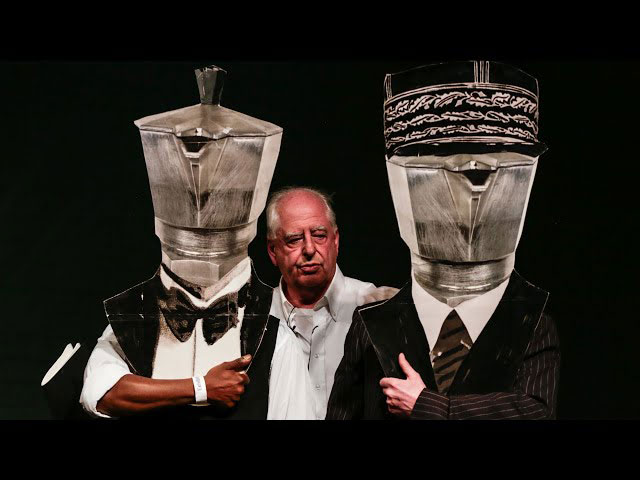
In spite of the wealth of images the pace was meditative enough
to make one ponder other sea voyages, migrant boats and slave
ships, other stories of exodus, lost homelands, lost dreams of
freedom. Is Charon's passage from Marseille to Martinique telling
us that trying to escape tyranny means boarding a ship of fools?
One could wonder. Yes or no.
|